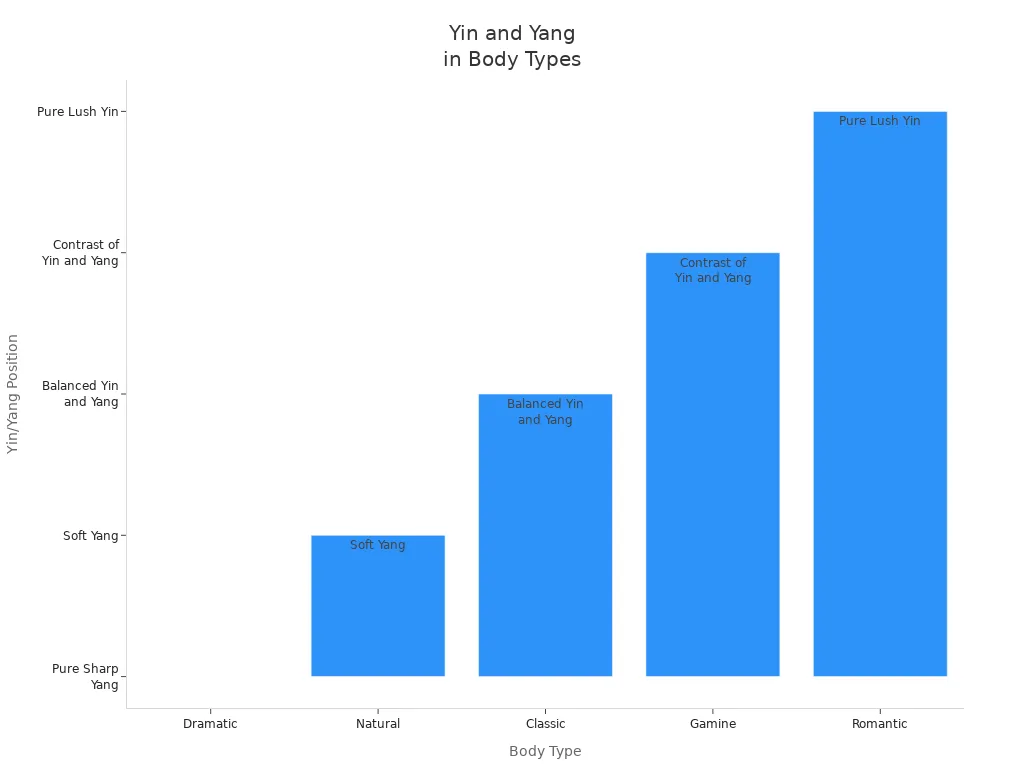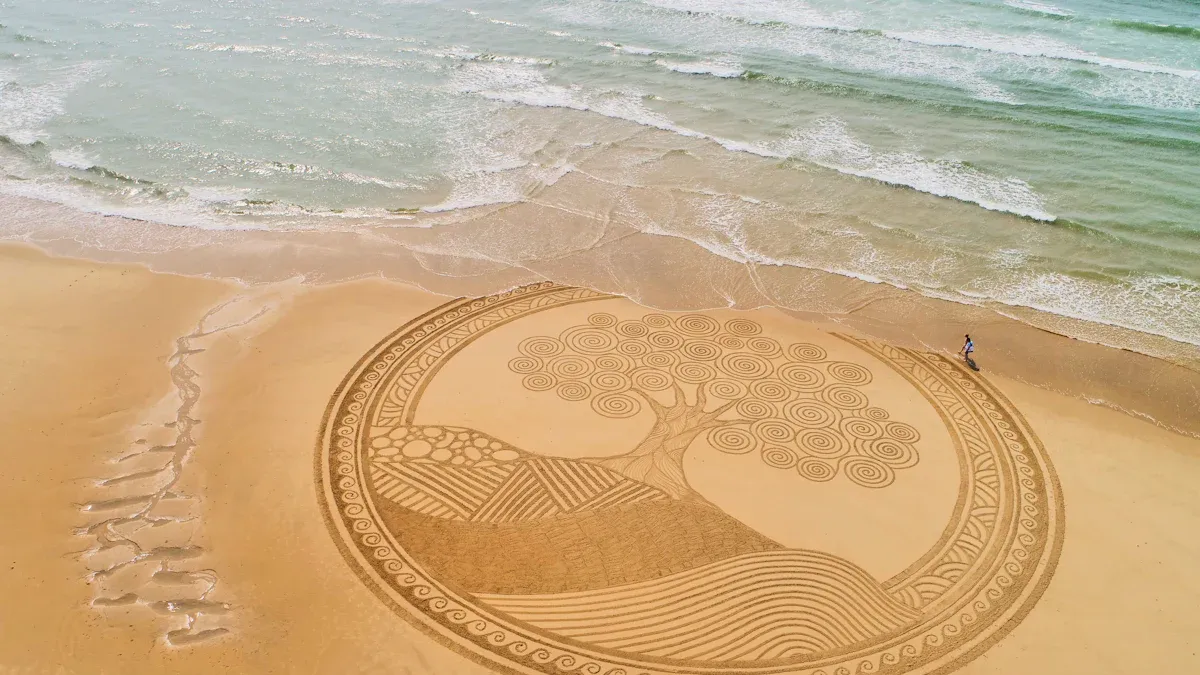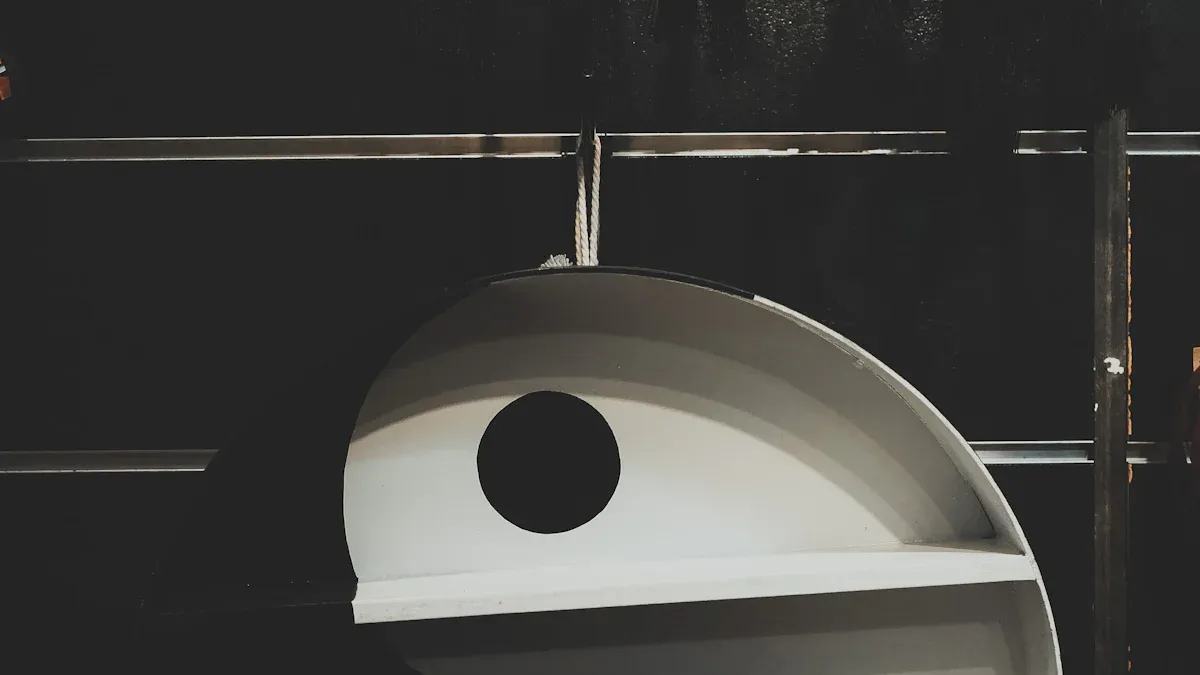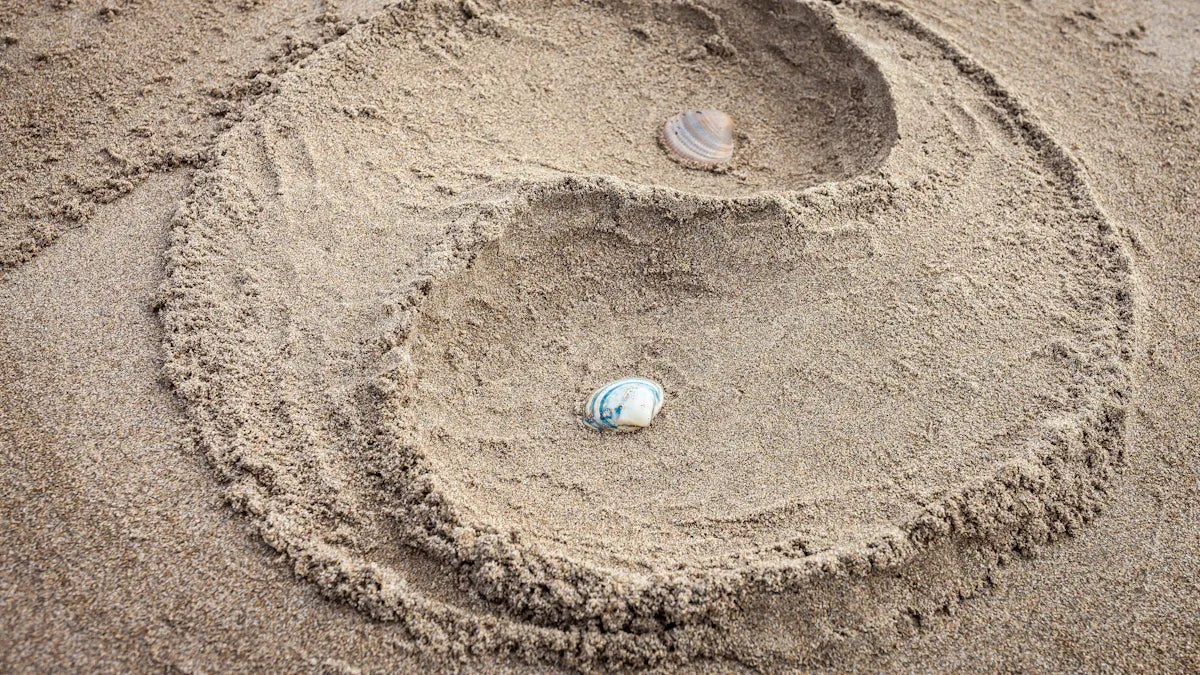Have you ever thought about why some people look soft and round, while others have sharp, straight lines? Yin and yang in body shapes explain these differences. Yin means curves, softness, and shorter parts. Yang stands for angles, structure, and longer lines. Both yin and yang can be in any body shape, no matter the size or gender. Knowing about this balance helps people accept their bodies and pick styles that make them feel sure of themselves.
Key Takeaways
Yin and yang show soft, curved shapes and sharp, straight lines in bodies. This helps people see what makes their look special. Everyone has both yin and yang traits. This makes every body shape unique and helps people accept themselves. The Kibbe system uses yin and yang to sort body types. It helps people pick clothes that fit their shape. Yin-dominant bodies have soft curves and look gentle. Yang-dominant bodies have sharp angles and look bold and tall. Balanced body types have both yin and yang features. This lets people try different styles and look classic. Wearing clothes that match your yin-yang balance makes you feel good. It also shows off your best features. Forgetting myths about yin and yang helps people like all body shapes. It stops judgment and stereotypes. Fashion in 2025 likes all kinds of people. It helps everyone find styles that fit their yin-yang mix.
Yin and Yang Basics
Yin and yang show how different qualities balance in every body. These words come from old Chinese ideas. At first, they described things like the sun and shadows, or day and night. Later, people used yin and yang to talk about how bodies look and feel. In Chinese medicine, yin means cool, dark, and soft. Yang means warm, bright, and active. This balance changes how someone looks and feels.
Yin and yang do not mean anything about weight, gender, or beauty. They are just ways to talk about how bodies are built. Everyone has their own yin-yang mix. This makes each person special.
Yin Features
Soft Lines
Yin features show up as soft, round lines on the body. These lines make the body look gentle and smooth. People with more yin have small bones and soft shapes. Their bodies may look shorter and less sharp in places like the shoulders, hips, or jaw.
Curved Shapes
Curved shapes are a big sign of yin. You can see these curves in the waist, hips, thighs, or face. The body feels soft and full, which gives it a gentle energy. Some style guides, like the Kibbe system, say yin means roundness, pretty details, and a soft look. Yin shapes feel warm and welcoming.
Feature Aspect |
Yin Characteristics |
Yang Characteristics |
Blend/Contrast Explanation |
|---|---|---|---|
Bone Structure |
Rounded edges, delicate bones, smaller stature |
Sharp edges, angular bones, elongated stature |
Yin and Yang can blend (moderate features) or contrast (distinct yin and yang features in one body) |
Body Flesh |
Soft, fleshy, voluptuous, curves |
Taut, lean, muscular, straight lines |
Yin flesh is soft regardless of weight; Yang flesh is taut and lean |
Facial Features |
Round eyes, rounded nose, full lips, soft jawline |
Angular eyes, sharp nose, thin lips, pronounced jawline |
Faces can be blended (moderate features) or contrasting (distinct yin and yang features) |
Overall Energy |
Soft, lush, feminine, flowing |
Bold, sharp, statuesque, angular |
Yin and Yang are complementary forces influencing style essence and silhouette |
Style Implication |
Emphasizes softness, curves, rounded silhouettes |
Emphasizes sharp lines, elongation, angular silhouettes |
Style guides use yin/yang to guide fashion choices, fabric, and silhouette to harmonize with body essence |
Yang Features
Sharp Angles
Yang features look like sharp angles and straight lines. These traits make the body look bold and tall. People with more yang have long arms and legs, strong shoulders, and a clear jaw. Their bodies look taller and more shaped, with sharp edges at the joints and face.
Structured Forms
Structured forms are what yang is all about. The body feels firm, with tight muscles and not much softness. The shape looks long and smooth. In style systems, yang means simple lines, few details, and a strong look. Yang shapes show energy and confidence.

Yin-yang structure is not a strict rule. Most people have both yin and yang features. This mix makes many different body shapes and styles.
Yin and yang work together in every body. They make a moving balance, not a set group. Books and style guides agree: yin-yang helps people enjoy their own body shape and find what fits them best.
Yin-Yang in Body Types

Everyone has their own yin-yang mix that shapes how they look. The way yin and yang balance in bodies makes people look different from each other. Some people have more yin, some have more yang, and many have both. When you know about this balance, you can pick clothes that show your best features and help you feel good.
Yin-Dominant
Yin-dominant bodies have more soft curves and round shapes. The Kibbe system says these people have gentle lines, small bones, and a soft, feminine feel. In Chinese medicine, yin-dominant bodies are linked to certain health patterns. For example, women often have more yin, which connects to blood stasis and yang-deficiency. Men with more yin might have damp-heat or qi-deficiency, often because of how they live.
Manifestation in Yin-Dominant Body Types |
Explanation / Supporting Details |
|
|---|---|---|
Gender - Female |
More yang-deficiency and blood stasis constitutions |
Linked to physiological functions like menstruation and parturition causing blood stagnation; yin predominates yang in females (TCM theory). |
Gender - Male |
More damp-heat and qi-deficiency constitutions |
Possibly due to lifestyle habits such as tobacco and alcohol use and preference for greasy, salty diet leading to phlegm-dampness accumulation. |
Age |
Increase in yin-deficiency with age; higher blood stasis in older groups |
Aging weakens kidney-essence and qi/blood circulation, causing chronic illness and appearance of yang-deficiency and blood-stasis constitutions. |
Education |
Less-educated groups show more yin- and yang-deficiency types |
Education influences constitution; higher education linked to phlegm-dampness, but also stress-related biased constitutions. |
Environment |
Humid climate (e.g., Macau) increases phlegm-dampness constitution |
Geographic and climatic factors contribute to constitution types, with humid, muggy climate favoring phlegm-dampness. |
People with yin-dominant bodies often have soft outlines, round shoulders, and full cheeks. The Kibbe system calls these "Romantic" or "Soft Classic." These people look best in clothes that follow their curves and use soft fabrics. Their yin-yang balance gives them a gentle and friendly look.
People with more yin should be proud of their curves and softness. Wearing the right clothes can show off their beauty and make them feel balanced.
Yang-Dominant
Yang-dominant bodies have sharp angles, long arms and legs, and a bold look. The Kibbe system lists types like Dramatic, Soft Dramatic, and Natural as yang. These people have strong bones, straight lines, and look tall. Their bodies are narrow and have clear edges.
Body Type |
Yang Influence |
Height |
Bone Structure & Edges |
Body Flesh Characteristics |
Facial Features |
Weight Gain Effects |
|---|---|---|---|---|---|---|
Dramatic |
Pure Yang |
Tall, elongated |
Narrow frame, sharp edges |
Very skinny, flat bust, straight waist and hips |
Sharp, angular face; small eyes, thin lips |
Waist definition disappears; weight on hips/thighs; remains tall |
Soft Dramatic |
Yang dominant |
Moderate to tall |
Large, angular frame |
Fleshy bust and hips, moderate waist |
Prominent facial bones; large eyes, full lips, fleshy cheeks |
Weight accumulates on bust, hips, waist, thighs, upper arms, face |
Natural |
Yang dominant with some Yin |
Might look tall and broad |
Broad shoulders with blunt edges |
Muscular but lean flesh, flat-ish bust, straight waist and hips |
Wide angular face with blunt edges; wide-spaced eyes, broad lips |
Weight on abdomen; softer jaw; wider shoulders; body looks squarish |
The Kibbe system helps people see their yang traits. Yang-dominant people often look strong and full of energy. They look great in clothes with straight lines, bold shapes, and firm fabrics. Their yang energy makes them look sure of themselves.
Picking clothes that match yang features can help people feel powerful. The right fit brings out their best shape.
Balanced Types
Some people have both yin and yang in their bodies. The Kibbe system calls these "Classic" or "Soft Classic." These people have both curves and straight lines. Their bodies do not show too much yin or yang. Instead, they look even and balanced.
Balanced types are usually medium height, have even shoulders, and a mix of round and sharp features. Their faces can look both soft and strong. The body type system says this balance gives a classic and stylish look. People with balanced yin-yang can wear many styles and look good in both soft and firm clothes.
Having a balanced yin-yang mix lets people try many styles. They can show more yin or yang, depending on what they want.
Knowing about yin-yang in body types helps everyone pick styles that fit them best. The Kibbe system and Chinese medicine both say every body has its own mix. By learning about yin and yang, people can feel happy and confident with how they look.
Kibbe System Overview
The kibbe system is a special way to look at body types. It is different from old body type systems. Kibbe looks at how yin and yang show up in each person’s features. This way helps people like their own shape and lines. It does not make people fit into strict groups. The kibbe image identity system helps people match their look with their style.
Five Main Types
The kibbe system puts body types into five big groups. Each group has its own yin-yang mix. These groups are the base of the kibbe archetype system. The table below shows how each group looks in bones, body flesh, and face:
Type Family |
Yin/Yang Balance |
Key Characteristics |
Bone Structure |
Body Flesh |
Facial Features |
|---|---|---|---|---|---|
Dramatic |
Sharp Yang (no Yin) |
Elongated, sharp edges |
Tall, narrow, sharp shoulders, long limbs, large narrow hands/feet |
Flat bust, straight waist/hips, taut flesh |
Prominent, angular features, small eyes, thin lips |
Natural |
Soft Yang (some Yin) |
Tall but broad, blunt edges |
Tall, broad, wide blunt shoulders, long limbs, large wide hands/feet |
Wide bust, straight wide waist/hips, taut muscular flesh |
Wide angular features, wide eyes, broad lips |
Classic |
Balanced Yin/Yang |
Symmetrical, moderate features |
Moderate height, balanced shoulders, moderate limbs, proportionate hands/feet |
Evenly proportioned bust, waist, hips, balanced flesh |
Symmetrical, moderate facial features |
Gamine |
Combination Yin and Yang |
Petite Yin or sharp Yang, not blended |
Varies, often a mix of sharp and soft lines |
Varies |
Varies |
Romantic |
Predominantly Yin |
Soft, rounded, feminine lines |
Rounded bone structure |
Soft, curvy flesh |
Full, rounded facial features |
The kibbe image identity system has more than just these five groups. There are mixed types too, making 13 kibbe types in all. Each type has its own yin-yang mix. This helps people know their style and how to show it.
The kibbe archetype system does not say who is pretty or not. It shows that every person’s look is special and important.
Yin-Yang Spectrum
The kibbe system puts body types on a yin-yang line. Yin means soft, curved, and round shapes. Yang means sharp, angled, and long lines. Each kibbe type fits somewhere on this line. This depends on bones, body flesh, and face. For example, Dramatic types have lots of yang with tall, sharp bodies. Romantic types have lots of yin with soft curves and gentle features.
Most people have both yin and yang traits. The kibbe system wants people to see what makes them unique. It helps people pick clothes, hair, and makeup that fit their look. This is not like Chinese medicine, which uses yin-yang for health. In kibbe, yin-yang is about how you look and dress.
The kibbe archetype system uses essence to help people. It lets people match their style with their natural lines. When people know where they are on the yin-yang line, they can pick styles that make them feel good and strong.
Using the kibbe system helps people like themselves more. The kibbe image identity system helps everyone feel proud of their own beauty.
Contrast of Yin and Yang

Visual Differences
The contrast of yin and yang stands out in how people look. Yin features show up as soft curves and gentle lines. A person with more yin often has rounded shoulders, a small waist, and full cheeks. Their body looks smooth and flowing. Clothes that follow these curves make them look even softer.
Yang features appear as sharp angles and straight lines. People with more yang have long arms, strong shoulders, and a clear jawline. Their bodies look tall and bold. Outfits with straight cuts and firm fabrics highlight these shapes. When someone stands next to another person with the opposite balance, the difference becomes clear. One looks gentle and rounded, while the other looks strong and structured.
A table can help show these differences:
Feature |
Yin Traits (Soft) |
Yang Traits (Sharp) |
|---|---|---|
Shoulders |
Rounded |
Angular |
Waist |
Defined, small |
Straight, less defined |
Face |
Full cheeks, soft jaw |
Strong jaw, sharp cheekbones |
Arms/Legs |
Shorter, soft |
Long, straight |
People who understand these visual cues can choose styles that match their natural lines. This helps them feel more confident and comfortable.
Common Misconceptions
Many people misunderstand yin and yang in body shape analysis. They often think yin means feminine and yang means masculine. This idea is not true. Yin and yang describe shapes, textures, and details, not gender. Both men and women can have yin or yang features.
Some believe that "fleshiness" means body weight or size. In the Kibbe system, fleshiness means how soft or firm the flesh looks on the bones. A person can have soft flesh and still be slim. Others think that yin and yang must be the same in every part of the body. In reality, bone structure, body flesh, and facial features can each have their own yin or yang balance.
People sometimes try to fit everyone into simple or gendered categories. This approach misses the true goal of the system. The yin-yang balance is about celebrating each person’s unique look. It does not judge or rank body types.
-
Common misconceptions include:
Equating yin with feminine and yang with masculine
Confusing fleshiness with weight or BMI
Believing yin and yang must match across all body parts
Overlooking the unique mix in each person
Trying to fit types into strict or gendered boxes
When people let go of these myths, they can see the beauty in every natural body shape. Understanding the real contrast of yin and yang helps everyone find their best style and feel proud of who they are.
Identify Yin-Yang
Understanding your own yin-yang mix helps you choose styles that fit your natural body shape. The kibbe system gives everyone a way to see their unique features. Use this simple guide to start your self-discovery:
Bone Structure
Start by looking at your bones. Stand in front of a mirror and notice your shoulders, arms, and legs. Are your bones sharp and long, or round and small? People with yang bones often have straight shoulders, long limbs, and clear edges. Yin bones look softer, with rounded shoulders and shorter arms or legs. The kibbe system uses bone structure as the first step to find your place on the yin-yang line.
-
Checklist for Bone Structure:
Shoulders: Are they sharp (yang) or rounded (yin)?
Arms/Legs: Are they long and straight (yang) or short and soft (yin)?
Hands/Feet: Are they large and narrow (yang) or small and rounded (yin)?
Tip: No one has only yin or only yang bones. Most people have a mix. The kibbe system celebrates this balance.
Body Flesh
Next, look at how your flesh sits on your bones. The kibbe system says flesh distribution changes how people see yin or yang. Yang types show lean, muscular flesh and sharp lines. Yin types have soft, rounded flesh and curves. For example, Dramatic types have sharp bones and weight on hips or thighs, which keeps their yang lines strong. Soft Dramatic types mix sharp bones with soft, rounded flesh, adding yin softness to a yang frame. Classic types show a balance, with even flesh and smooth lines. Theatrical Romantic types lean toward yin, with soft arms, legs, and a voluptuous figure.
-
Checklist for Body Flesh:
Is your flesh soft and rounded (yin) or taut and lean (yang)?
Do you see curves in your waist, hips, or thighs (yin)?
Does your body look more straight and muscular (yang)?
Choosing clothes that match your kibbe type helps you feel comfortable and confident. The right fit brings out your best features and supports your natural body shape.
Facial Features
Facial features also show yin or yang. The kibbe system looks at the shape of your eyes, nose, lips, and jaw. Yin faces have round eyes, full lips, and soft jawlines. Yang faces show sharp cheekbones, thin lips, and strong jaws. Even facial color can give clues. Research shows that yin-deficient faces look redder and less bright, while yang-deficient faces appear pale and dark.
Deficiency Type |
Facial Color Characteristics |
Color Parameter Changes |
Interpretation |
|---|---|---|---|
Yin Deficiency |
Red facial color, less bright |
Increased red values (R, 'a'), decreased luminance (L) |
Face appears redder but less bright; aligns with traditional descriptions of bright red face |
Yang Deficiency |
Pale and dark facial color |
Decreased luminance (L) |
Face appears pale and dark; consistent with traditional descriptions |
-
Checklist for Facial Features:
Are your eyes round and lips full (yin) or are your features sharp and thin (yang)?
Does your face look soft and lush (yin) or bold and angular (yang)?
Notice your skin tone: Is it bright and red (yin-deficient) or pale and dark (yang-deficient)?
Everyone has a unique mix of yin and yang. The kibbe system helps you see your own beauty. Accept your balance and let it guide your style choices.
Embrace Yin-Yang
Styling Tips
Everyone can look their best by using their own yin and yang mix. The kibbe system gives easy tips for picking clothes that fit this balance. If you have more yin features, show off your curves and soft lines. Wear clothes that hug your waist and use light, flowing fabrics. Soft colors and gentle prints look great on yin types. Pure yin types, like Romantic, should not wear stiff or harsh clothes. They look best in outfits that follow their curves and have pretty details. If you have some yang with your yin, like Soft Dramatic or Soft Gamine, try mixing bold lines with soft shapes. You can add structure at the shoulders or waist but keep the look gentle.
Yang-dominant people look good in styles that match their strong lines. The kibbe system says to use sharp edges on shoulders, cuffs, and collars. A clear waist shape stops clothes from looking too big. Short, neat lines and broken curves work for yang Soft Gamine types. Dramatic types look best in long, straight clothes with few details. Clothes should show your body's real shape, not hide it. This helps your true style and confidence shine.
Balanced types, like Soft Classic, need clothes that are smooth and even. Pick outfits with soft lines and gentle shapes. Do not wear clothes with sharp angles or too many fancy details. A little waist shape and soft lines make a classy look. The goal is to match your body's shape and let your style show.
The kibbe system wants everyone to dress for their own style, not just follow trends. When you dress for your yin-yang balance, you feel happy and sure of yourself.
Self-Acceptance
Accepting your yin-yang mix brings many good things. People who know their kibbe type often feel calm and happy inside. They love themselves and do not need others to tell them they look good. This helps them feel relaxed in groups and talk with both kindness (yin) and strength (yang). It also helps stop worry and makes talking to others easier.
Inner peace: People feel calm and accept themselves.
Outer peace: They talk to others with kindness and confidence.
Less worry: A good yin-yang mix helps with talking and feeling calm.
Balancing yin and yang means knowing your strengths and limits. People learn to handle hard times and focus on what matters. The kibbe system says every style is special. When you respect your own body and style, you feel good about yourself and others.
Loving your yin and yang is not just about clothes—it is about living with joy and confidence. The kibbe system helps everyone see their own beauty and feel proud.
Future of Body Types
Trends for 2025
Fashion in 2025 is all about showing what makes each person special. Designers want clothes to fit everyone, no matter their age or body shape. The babydoll style, which used to be just for young people, is now made for older women too. People use colors and layers to feel good and look nice. Maximalist styles use lots of layers and big shapes. These let people show off what they like best about themselves. These new styles help people feel free and creative. Anyone can feel sure of themselves.
The kibbe system works well with these new styles. People use kibbe to learn about their body lines and pick clothes that fit them. Brands now use models of all ages, sizes, and genders. At New York Fashion Week Fall/Winter 2025, designers like TTSWTRS used clothes to tell stories about people. They showed that fashion is about being yourself, not following old rules.
The kibbe way helps people see what makes them strong. When they dress for their kibbe type, they feel happy and proud. The 2025 styles make sure there is something for every kibbe type.
Beyond Stereotypes
Fashion brands are moving away from old ideas about body shapes. They make more sizes and use stretchy fabrics and waistbands that adjust. Aerie’s Real Me collection shows that brands listen to what real people want. Companies like ASOS use words that work for everyone and let people shop by style, not gender. Savage X Fenty uses models of all sizes, shapes, and backgrounds. This shows that being different is important, not just a trend.
Brands use AI to help people shop for clothes that fit them. Smart tools suggest outfits based on your size and what you like.
AI helps people buy the right clothes and feel good about shopping. People see models like themselves and feel understood.
Gender-free fashion is getting more popular. Stores like Zara and ASOS have clothes for everyone, not just boys or girls.
Online shops now have "all-gender" sections and size charts that use body shape, not gender.
Social media and AI help people show who they really are.
The kibbe system is important in this new world. It helps people learn about their features without using labels. By looking at lines and balance, kibbe helps everyone find their own style. This fits with how fashion is becoming more open and kind.
The future for body types is exciting. The kibbe method and new styles help break old rules. They invite everyone to enjoy fashion and be proud of who they are.
Knowing about yin and yang in body shapes helps people notice what makes them special. These ideas, like in the Kibbe system, show people how to dress for their own body. This helps them feel good about themselves. When people see yin and yang as both important, they can like all kinds of bodies and not just follow what is popular.
Watch how your energy changes during the day to spot yin and yang.
Wear new clothes that fit your body’s natural shape.
Think about what you try and be happy about what makes you different.
Everyone should feel happy with their own body and show who they really are.
FAQ
What does yin and yang mean in body shapes?
Yin and yang describe the balance of soft and sharp features in a person’s body. This idea helps people understand their natural body shape and choose styles that highlight their best qualities.
Can anyone have both yin and yang features?
Yes! Most people show a mix of yin and yang traits. This unique blend makes every person’s natural body shape special. Embracing both sides helps people feel more confident and stylish.
Does yin or yang mean someone is a certain gender?
No. Yin and yang do not relate to gender. Both men and women can have yin or yang features. Everyone should celebrate their own natural body shape, no matter their gender.
How can someone find their yin-yang balance?
A person can look at their bone structure, body flesh, and facial features. Using guides like the Kibbe system, they can discover their yin-yang mix and dress to match their natural body shape.
Will knowing my yin-yang type help with fashion choices?
Absolutely! Understanding yin and yang helps people pick clothes that fit their natural body shape. This knowledge leads to better style, comfort, and self-acceptance.
Is the Kibbe system only for women?
No. The Kibbe system works for everyone. Men and women can use it to learn about their natural body shape and find styles that suit them best.
Why should someone care about yin and yang in body shapes?
Knowing about yin and yang helps people accept their natural body shape. This acceptance builds confidence and encourages them to try new styles that highlight their unique features.










